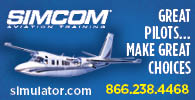Things can go wrong in an airplane in countless ways. The outcome has almost as much to do with how the pilot handles it as it does the original fault.
Twin Commander Instructor Barry Lane said his dad would tell him, “Don’t turn an emergency into a crisis.” It’s sound advice that acknowledges a few important truths about flying during abnormal or emergency situations. Rare is the emergency that requires split-second action, and the outcome is usually most successful when we approach the situation methodically.
Lane has taken the advice to heart by teaching that the first step to any emergency is to first determine who is flying the airplane. “You’ve heard that you should ‘wind your watch,’” he said. “This gives you the chance to do something without actually doing it.” In other words, Lane is recommending that the first step isn’t to grab the checklist, key the radio, get out a flashlight, or shut down an engine. It’s to take a breath and ask yourself who’s flying. Is it you? The autopilot? Someone else? This step also has the benefit of quickly assessing the condition of the flight controls, the autopilot, and yourself. “If you stay caught up to the airplane, when that crazy thing happens, the answer to who’s flying the airplane comes quickly,” he said.
Only after it’s clear who has control do you move on to taking a quick inventory. What is working and what isn’t? Lane gives the example of an instructional flight when they heard a loud bang at decision height right after the pilot had applied power to go missed. Lane immediately grabbed the controls, determined he was flying, felt the big yaw characteristic of an engine failure, and began to run the memory items. The checklist begins not with identify, verify, feather, but with cleaning up the airplane. He raised the gear and flaps, and went to start working on the engine. But as he was about to cage the engine, the yaw went away and the airplane started flying normally. They decided to continue on, and it was only after landing that they saw the problem. A flap cable had snapped, causing a loud bang and a hasty and strong roll and yaw.
If Lane hadn’t followed his own advice, and instead starting doing something without taking in what was happening, it’s likely he would have feathered a good engine. And that’s assuming he would have reacted correctly. The accident record is packed with one tragedy after another where the pilot secured the wrong engine, usually because pilots feel the need to react immediately.
Another benefit of the strategy is the potential of putting more time back on the clock. The negative torque sensor on the Twin Commander is a great example. If an engine flames out on takeoff and the pilot quickly and correctly feathers the engine, he may have actually created a problem because the NTS didn’t have time to work. “We’ve turned it into a crisis by having fast hands,” Lane said. “Allow the safety features of the airplane and the design parameters to work for us.”
We all want to take care of problems quickly. Even minor issues sometimes feel urgent in the confines of a cockpit. But, Lane says, “You have a moment. Take that moment.” Being a good pilot in command doesn’t mean you are able to solve a situation quickly. There are no extra points for speed. It means you are able to solve it correctly and safely, and sometimes that takes a few seconds or minutes.




